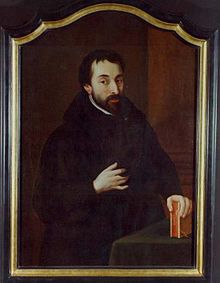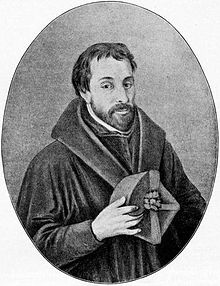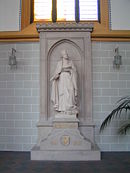Friedrich Spee
Friedrich Spee von Langenfeld (born February 25, 1591 in Kaiserswerth near Düsseldorf , † August 7, 1635 in Trier ) was a German Jesuit . He became famous as a critic of the witch trials , through his writing Cautio Criminalis , but also as a hymn poet . The Archdiocese of Cologne lists him as a saintly person .
Surname
The family name of the noble family Spee was "Spede" in earlier times; Over the centuries it was changed to "Spe" or "Spee". The addition "von Langenfeld" refers to the origin of his family branch from the manor Haus Langenfeld in Wachtendonk-Wankum .
The term "Friedrich von Spee", which is sometimes used even by institutions, is incorrect, Friedrich Spee von Langenfeld is correct. Several schools were named after him; there are Friedrich-Spee-Gymnasien in Geldern , Rüthen and Trier and a secondary school in Neumagen-Dhron .
Life
Friedrich Spee von Langenfeld was born in Kaiserswerth near Düsseldorf in 1591 as the son of a high official in Cologne . His parents were Peter Spee von Langenfeld († before 1612) and Mechtel (Mechtild) born Nunum called Dücker (* around 1565) from Altenkriegenbeek . He probably had two sisters and two brothers.
He enjoyed a good upbringing and the work of the local pastor Caspar Ulenberg should not have remained without influence on Spee. In 1610, at the age of 19, he entered the Jesuit order against the will of his parents in Trier . Since the plague broke out in Trier , he moved to Fulda and made his first vows there in 1612 . After three years in the novitiate , he completed the planned study of philosophy in Würzburg from 1612 to 1615 . In 1617 the order rejected his wish to go to India as a missionary . In 1616/17 he taught under the rector there, Father Wilhelm Wolff von Metternich zur Gracht, at the Jesuit College in Speyer .
After completing his theology studies in Mainz 1619–1623, Friedrich was ordained priest on March 28, 1623 in Mainz Cathedral . After completing his studies, he worked as a lecturer at the Jesuit University in Paderborn from 1623 to 1626 and was a cathedral preacher in Paderborn . He completed his tertiary degree in Speyer (1626/27) , the third probationary year of the order.
From autumn 1627 Spee taught at the colleges in Wesel and Cologne and drafted spiritual texts for the pastoral care of the Cologne devotees (pious women), which were later published as Das Güldene Tugendbuch . It is a kind of devotional book on the three divine virtues of faith, hope and love.
In October 1628 he was commissioned in Peine the recatholicization enforce. The citizens of Peine were given the choice of either leaving the city or accepting the Catholic faith. It is believed that this was the reason for the attack on Friedrich Spee in 1629, in which he was seriously injured.
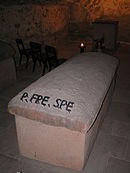
Spee crypt with sarcophagus under the Jesuit church in Trier
|
After Friedrich had recovered from his injuries, he received a professorship for moral theology in Paderborn in 1629 , which was withdrawn from him in 1631 due to strong opposition in the order to his teaching content.
In 1630 the general of the Jesuits, Father Vitelleschi, turned against disciplinary action in the "Spee case", but could not prevent his impeachment in 1631. In January 1632 Vitelleschi spoke out in favor of the reinstatement of Spees as professor of moral theology, in August of the same year, after the publication of an anonymous edition of the Cautio Criminalis , but in favor of dismissal from the Society of Jesus.
In 1633, two years after the Cautio criminalis was published , the order transferred him to Trier as professor of casuistry and confessor of prisons and hospitals . There consummate Spee probably already ten years earlier started "Trutznachtigall," a collection of ornate lyrical poems and still known hymns , the posthumously published in 1649 in Cologne.
While caring for wounded and plague soldiers in Trier, he became infected and died on August 7, 1635 at the age of 44. His body is buried in a crypt named after him under the Trier Jesuit Church at the Trier seminary , the former Jesuit college. He was initially buried there between his fellow brothers, and it was not until 1980 that his grave could be identified during archaeological investigations. The crypt was then restored and made accessible, Spee's bones now rest in a late antique sarcophagus placed there.
Criticism of torture and witchcraft

Around the same time as Johann Matthäus Meyfart's Christian Remembrance in Lutheranism and 30 years after Anton Praetorius' "Thorough Report on Magic and Magicians" , Spee's Cautio Criminalis appeared anonymously in May 1631 , which presented the first objections to torture and belief in witches in the Catholic area . A clearer title such as “Against the Witch Mania ” would have been a clear violation of generally prevailing beliefs. The very designation cautio - caution was suitable to suspect the author (as well as printer and publisher) of protecting witches and thus strengthening the party of Satan , which is why the writing could only appear anonymously.
According to recent research (Franz 2001, p. 122f) it is not certain whether Spee, as confessor of “ witchcraft ”, looked after women accused of " witchcraft " or accompanied them to the stake . Certainly, however, he observed witch trials during his stay in centers of the witch hunt ( Cologne , Trier , Würzburg , Mainz , Speyer and Paderborn ) . Contrary to the legal opinion of the time, he pointed out that torture might not serve to establish the truth. From this he derived the then bold assumption that the suspected women were innocent, although they had confessed their guilt under torture. Within the Society of Jesus his authorship of the dangerous script could not remain hidden, and at times he was threatened with dismissal from the order. However, recent research suggests that the second edition of the Cautio Criminalis (1632) was published with the approval of the Jesuit provincial leadership. The legal implementation of Spee's views was later mainly carried out by Christian Thomasius , who contributed significantly to the abolition of the witch trials.
A sister-in-law of Friedrich Spee, Anna Spee von Langenfeld , wife of his half-brother or cousin Robert Spee von Langenfeld, was executed on September 20, 1631 as the " Witch Queen of Bruchhausen ".
The poet
Spee's main lyrical work is an artistically compiled collection of 52 sacred chants Trutznachtigall or spiritual-poetic Lustwäldlein , which was only published posthumously in 1649 by Wilhelm Friessem in Cologne. In it, Spee shows himself to be a very independent and original baroque poet, who, according to his own admission, is concerned with nothing else “than that God also has his poets in German, who sing and proclaim his praise and name just as artificially as others in their languages can".
In addition to his native Ripuarian language, he also used idioms of the Mainz, Würzburg and other southern German dialects he had learned (for example in the “Trutznachtigall”) .

In it Spee proves to be a poeta doctus , which is formally linked to the ancient shepherd poetry , especially Virgil , but transfers its pagan imagery into the motivic context of a theologically or christologically accentuated, spiritual passion poetry. Since his rediscovery during the German Romantic period, Spee has been considered the most important Catholic poet of the German Baroque . His imagery and the tradition of shepherd poetry , alien to the modern reader, can make access difficult today.
In addition to the Trutznachtingall , Friedrich Spee also composed a large number of hymns , all of which, however, appeared anonymously. Some of these songs are still very popular today and can be found in the modern hymn books of the two major denominations . In the Catholic prayer and hymn book God praise from 1975 and 2013, respectively, the Advent song O Savior, tear open the heavens , the Christmas carol Born in Bethlehem , the Passion song O sadness, o heartache , the songs of saints you friends of God all at the same time and invincible hero (only Praise to God 1975), the Marian song Let us rejoice heartily and the Easter songs The whole world, Lord Jesus Christ and Is that the body, Lord Jesus Christ . The Christmas carol Vom Himmel hoch, o angel comes (printed in some regional parts of the Evangelical Hymnal ) is also attributed to him.
The spiritual writer
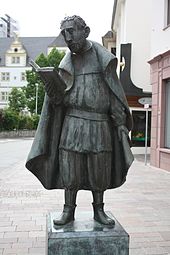

At the urging of the head of a women's community in Cologne ("Devotessen"), Friedrich Spee wrote a weekly paper for a year in 1627 with aids for prayer and spiritual reflection. These texts were then compiled by Spee as Güldenes Virtue Book . These are not just pious texts, but instructions for practicing:
- Because everything is designed for use and not just for reading.
The three divine virtues of faith , hope and love should be practiced , with Spee placing the greatest emphasis on the last of these three virtues, love.
The biggest praise found among other things in terms of scholastic moral theology of Thomas Aquinas working Güldene virtue book at Gottfried Wilhelm Leibniz , the preface for the Electress Sophia Charlotte of Hanover translated into French:
- His German book Gülden-Tugend-Kleinod seemed to me to be a very divine book and I wanted it in the hands of all Christians. There are many authors of mystical theology, but I don't know if anyone has ever written such a solid devotional book. [...] I was marvelously moved whenever I read his discussion on the nature and effectiveness of divine love. I do not know whether any writer who has written for the people has treated this very important subject according to its worth, with the exception of this one author. (Quoted from Diel 1901, pp. 130f.)
Fonts (selection)
- Bell 'Vedére or Herbipolis Wurtzgärtlein or Würtzburger Lustgärtlein: in it a pleasure house, in the pleasure house an organ and all sorts of mottetti and concertos, that's all Catholic chants from Pentecost to Advent etc. and to be sung throughout the year: with a hundred and a thousand voices etc. . trucked bey Johan Volmar, Würzburg 1,621th
- Cautio criminalis, seu de processibus contra sagas liber ... Auctore incerto theologo orthod. , Petrus Lucius Rinteln 1631
- Conscience book: Of trials against the witches. Written to all high authorities in the Czech Republic without urgent motives [...]. Translated by Johann Seyffert. Köhler, Bremen 1647. Digitized and full text in the German text archive
- Cautio criminalis, seu de processibus contra sagas liber: that is, pal. Warschawung von Anstell: u. Conduct of the trial against d. specified wizards, witches and fiends ... / by e. Untamed Roman. Cath. ... into Teutsch trewl. over. sampt e. ordinary Reg. By HSS, Humm, Frankfurt a. M. 1649. Digitized edition 1 , 2
- Cautio Criminalis or: Legal concerns about the witch trials (Germanized by Joachim-Friedrich Ritter), dtv 1983, ISBN 3-423-06122-7
- Güldenes Tugendbuch , Cologne 1647 ( online - Internet Archive )
- Conscience book: Of trials against the witches. Köhler, Bremen, 1647. ( digitized and full text in the German text archive )
- Trutz-Nachtigall , ed. Theo GM van Oorschot. Bern: Francke 1985 (Ndr. D. Cologne 1649 edition)
- Friedrich Spee, Complete Writings . Historical-critical edition in four volumes, ed. by Theo van Oorschot. Bern: Francke 1968, 1985, 2005 (Cautio, 2nd edition and songs)
literature
s: Friedrich Spee # secondary literature
Monographs
- Frank Sobiech: Jesuit Prison Ministry in the Witch Trials of the Holy Roman Empire. Friedrich Spee SJ and his Cautio Criminalis (1631) , (Bibliotheca Instituti Historici Societatis Iesu, Volume 80). Institutum Historicum Societatis Iesu, Rome 2019, ISBN 978-88-7041-380-9 .
- Walter Rupp: Friedrich von Spee. Poet and fighter against the witch madness . 3rd edition Ostfildern 2011.
- Dieter Kunze (ed.): Friedrich Spee reading book . Berlin, Münster, 2010.
- Friedrich Spee. Priest, admonisher and poet. (1591–1635) , exhibition book, Archbishop's Diocesan and Cathedral Library, Cologne 2008, ISBN 978-3-939160-16-8 .
- Cornelia Rémi: Philomela mediatrix. Friedrich Spees Trutznachtingall between poetic theology and spiritual poetics , Lang, Frankfurt / M. 2006 (also dissertation, University of Munich 2004), ISBN 3-631-52765-9 .
- Frank Rustemeyer, only to the heavenly portals, all tone. Allegory in the work of Friedrich Spees , Mentis-Verlag, Paderborn 2003, ISBN 3-89785-369-8 .
- Gunther Franz (Ed.): Friedrich Spee on the 400th birthday. Colloquium of the Friedrich-Spee-Gesellschaft Trier , Bonifatius-Verlag, Paderborn 2001, ISBN 3-87088-778-8 .
- Friedrich Spee and the Northern Rhineland , exhibition, published by the University and State Library Düsseldorf, Düsseldorf 2000 ( digitized version )
- Helmut Weber, Gunther Franz: Friedrich Spee (1591–1635) , Friedrich Spee Society, Trier 1996, ISBN 3-87760-084-0 .
- Christian Feldmann: Friedrich Spee, witch lawyer and prophet , Herder, Freiburg 1993, ISBN 3-451-22854-8 .
- Theo van Oorschot: Between anger and tenderness. Friedrich Spee , (Personality and History, 140). Muster-Schmidt, Göttingen 1992, ISBN 3-7881-0140-7 .
- Anton Arens: Friedrich Spee. A dramatic life , Verlag Weyand, Trier 1991, ISBN 3-924631-25-5 .
- Martina Eicheldinger: Friedrich Spee. Pastors and poeta doctus. The tradition of the Song of Songs and influences of Ignatian devotion in his work , Niemeyer, Tübingen 1991 (plus dissertation, University of Heidelberg 1991), ISBN 3-484-18110-9 .
- Gunther Franz (Ed.): Friedrich Spee. Poet, pastor, fighter of the witch madness. Kaiserswerth 1591 - Trier 1635. Catalog of the exhibition in Düsseldorf 1991, Trier 1991.
- Spee - against the madness. 1591-1991. Ash Wednesday 1991 , exhibition, published by the main department “Building, Art and Technical Services” in the Episcopal Vicariate General, Diocesan Museum, Trier 1991.
- Doris Brockmann, Peter Eicher (ed.): The political theology of Friedrich von Spees . Fink, Munich 1991, ISBN 3-7705-2721-6 .
- Karl Keller: Friedrich Spee von Langenfeld (1591–1635). Life and work of the pastor and poet . Keuck, Geldern 1990, ISBN 3-928340-00-X .
- Karl-Jürgen Miesen: Friedrich Spee. Father, poet, witch lawyer , Droste-Verlag, Düsseldorf 1987, ISBN 3-7700-0741-7 .
- Emmy Rosenfeld: Friedrich Spee von Langenfeld. A voice in the desert (= sources and research on the language and cultural history of the Germanic peoples. New series, 2). Walter de Gruyter & Co., Berlin 1958.
- Johannes Baptista Diel: Friedrich Spe. 2nd revised edition by Bernhard Duhr . Herder, Freiburg 1901.
Articles and entries in reference books
- Spee, Friedrich von . In: Meyers Konversations-Lexikon . 4th edition. Volume 15, Verlag des Bibliographisches Institut, Leipzig / Vienna 1885–1892, p. 113.
- Guido Maria Dreves: Spee, Friedrich von . In: Allgemeine Deutsche Biographie (ADB). Volume 35, Duncker & Humblot, Leipzig 1893, pp. 92-94.
- Gerhard Dünnhaupt : Friedrich von Spee . In: Personal bibliographies on Baroque prints . Volume 5. Hiersemann, Stuttgart 1991, ISBN 3-7772-9133-1 , pp. 3928-3937 (list of works and literature).
- Michael Embach: Friedrich Spee. In: Biographisch-Bibliographisches Kirchenlexikon (BBKL). Volume 14, Bautz, Herzberg 1998, ISBN 3-88309-073-5 , Sp. 1497-1506.
- Rainer Mohrs: Songs by Friedrich von Spee in arrangements by Hermann Schroeder. To the reception of a baroque poet in the choral and organ music of a composer of the 20th century. In: Kirchenmusikalisches Jahrbuch 95, 2011, pp. 103-133.
- Herman Lohausen: P. Friedrich Spee SJ (1591–1635): Name - Nimbus - Origin - Relationship. In: Westdeutsche Gesellschaft für Familienkunde eV (Ed.): Yearbook 2012, Volume 274, Cologne 2012, pp. 113–152.
- Bernhard Schneider: Spee, Friedrich. In: New German Biography (NDB). Volume 24, Duncker & Humblot, Berlin 2010, ISBN 978-3-428-11205-0 , pp. 641-643 ( digitized version ).
- Valentin Herzog: Güldenes Tvgend-Bvch. In: Heinz Ludwig Arnold (Hrsg.): Kindlers Literatur Lexikon (= B.15). 3. Completely revised edition. JB Metzler, Stuttgart Weimar 2009, ISBN 978-3-476-04000-8 , p. 455 ff.
- Klaus Haberkamm: Trvtz Nachtigal or Geistlichs-Poetisch Lvst-Waldlein, never before seen the same in Teutscher sprach. In: Heinz Ludwig Arnold (Hrsg.): Kindlers Literatur Lexikon (= B.15). 3rd, completely revised edition. JB Metzler, Stuttgart Weimar 2009, ISBN 978-3-476-04000-8 , p. 455 ff.
- Rainer Decker: New sources on Friedrich Spee von Langenfeld and his family . In: Westfälische Zeitschrift 165 (2015) pp. 151-180 .
- Hans Daub, opponent of witch persecution - Two unknown letters from Friedrich Spee von Langenfeld In: Buchenblätter - Supplement to the Fuldaer Zeitung for Heimatfreunde 93rd year No. 1/2020 pages 10 and 11 .
Friedrich Spee as a literary figure
- Claus-Peter Lieckfeld: Lawyer of the Witches , Roman, Vedra Verlag, Munich 2011, ISBN 978-3-939356-23-3 .
- Hans Eschelbach: Hexenkampf , novel, Veritas-Verlag, Bonn 1935.
- Wolfgang Lohmeyer : Die Hexe , Roman, Area Verlag, Erftstadt 2003, ISBN 3-89996-017-3
- Wolfgang Lohmeyer: Der Hexenanwalt , Roman, Area Verlag, Erftstadt 2003, ISBN 3-89996-018-1
- Wolfgang Lohmeyer: The Cologne Tribunal , Roman, Area Verlag, Erftstadt 2003, ISBN 3-89996-019-X
magazine
- Spee yearbook , ed. from the working group of the Friedrich Spee societies, Trier 1994 ff.
Web links
- Publications by and about Friedrich Spee in VD 17 .
- Literature by and about Friedrich Spee in the catalog of the German National Library
- Works by and about Friedrich Spee in the German Digital Library
- Works by Friedrich Spee at Zeno.org .
- Friedrich Spee in the Internet Archive
- Friedrich Spee Society
- Friedrich Spee College in Neuss
- Comenius project on Friedrich Spees Cautio criminalis in Latin class
- Georg Dietlein: The almost forgotten person behind well-known songs: Friedrich Spee , in: kath.net, August 7, 2012 ( online )
- Gudrun Schäfer-Burmeister: Opponents of the witch hunt: Friedrich Spee and Christina von Schweden Konstanz, 2006. Historicum.net , accessed on December 29, 2017
Individual evidence
- ↑ Trutznachtigal . After the edition by Klemens Brentano, critically reissued by Alfons Weinrich. Herder Freiburg im Breisgau 1908, p. 7 ( limited preview in the Google book search); Catalogus personarum provinciae societatis Jesu ad Rhenum inferiorem (1594–1687) (StB Trier, Hs. 1620 / 407,1)
- ↑ Saints in Cologne ( Memento from August 9, 2012 in the Internet Archive )
- ↑ mobile-geschichte.de
- ↑ a b Gunther Franz (Ed.): Friedrich Spee on the 400th birthday. Colloquium of the Friedrich-Spee-Gesellschaft Trier . Paderborn, 1995
- ↑ Ulrich Grun : "He wrote a lot, especially against the Protestants" - Kaspar Ulenberg was born 450 years ago in Lippstadt. In: District of Soest (ed.): Calendar of the district of Soest. Soest 1998, ISBN 3-928295-29-2 , p. 95.
- ↑ Westphalian history sv 1631 ; 1629-1630: [1]
- ↑ Joachim Lehrmann : For and against the madness - witch hunt in the Hochstift Hildesheim , Lehrte 2000, ISBN 978-3-9803642-3-2 , p. 184ff.
- ^ Michael Embach: Friedrich Spee. BBKL vol. 14, Herzberg 1998, col. 1497-1506
- ^ Emmy Rosenfeld: Friedrich Spee von Langenfeld. A voice in the desert (= sources and research on the language and cultural history of the Germanic peoples. New series, 2). Walter de Gruyter & Co., Berlin 1958, p. 61 f. ( limited preview in Google Book search).
- ↑ Emmy Rosenfeld: Friedrich Spee [...]. 1958, pp. 61-74.
- ^ Emmy Rosenfeld (1958), pp. 294–352 ( Die Cautio Criminalis ), here: p. 329 f. and 344-346.
- ^ Frank Wegerhoff, Heiko Schäfer, WDR television documentary: Ancestors wanted - Wolfgang Niedecken; Rainer Decker, Neue Quellen zu Friedrich Spee von Langenfeld and his family , in: Westfälische Zeitschrift 165 (2015) pp. 160f.
- ↑ Emmy Rosenfeld (1958), p. 225 ( limited preview in the Google book search).
- ^ Emmy Rosenfeld: Friedrich Spee von Langenfeld. A voice in the desert. 1958, pp. 232-255 ( Geistliches Arkadien ), especially pp. 246-250.
- ^ Karl Keller: Friedrich Spee von Langenfeld (1591–1635). Life and work of the pastor and poet . Keuck, Geldern 1990, pp. 64-113.
- ^ Emmy Rosenfeld: Friedrich Spee von Langenfeld. A voice in the desert. 1958, pp. 112–147 ( Das Güldene Tugendbuch ); here: pp. 121–124 ( limited preview in Google book search).
- ^ Leibniz: Dialogue sur la nature des trois vertus divines, Foy, Esperance et charité; traduit de l'allemand du Pére Spee , in: Complete Writings and Letters , AA VI, 4th Berlin 1999. N 430 pp. 2517–2529, uni-muenster.de (pdf)
- ↑ Johannes B. Diel SJ, Friedrich Spe , 2nd ed. Freiburg 1901
- ↑ In the Latin original: “Sed divinus mihi plane visus est libellus ejus lingua Germanica scriptus, cui titulus est: Gülden-virtue-gem, quem vellem in omnium Christianorum esse manibus. Multi habentur autores mysticae theologiae, sed an unquam quisquam tanta solidae pietatis specimina scripto dederit, nescio. [...] Sed ut ad solida revertar, mirifice affectus sum, quoties ea legi quae de natura et efficacia amoris Dei super omnia disseruit. Nescio enim an quisquam unquam autorum qui in populi usum scripsere rem tantam uno nostro autore excepto pro dignitate attigerit. ”In: Leibniz: Complete writings and letters , AA VI, 4th Berlin 1999. N 430 p. 2515 (Maji 1677), uni -muenster.de (pdf)
| personal data | |
|---|---|
| SURNAME | Spee, Friedrich |
| ALTERNATIVE NAMES | Spee von Langenfeld, Friedrich (anachronistic) |
| BRIEF DESCRIPTION | German Jesuit, moral theologian, poet and spiritual writer |
| DATE OF BIRTH | February 25, 1591 |
| PLACE OF BIRTH | Kaiserswerth near Düsseldorf |
| DATE OF DEATH | August 7, 1635 |
| Place of death | trier |
